January 2022 Oregon ACP Resident Presentations

OHSU Internal Medicine Resident Clinical and Research Abstract Presentations
American College of Physicians Oregon Chapter Virtual Scientific Meeting
January 11, 2022
Winners
Oral Vignette Presentations
SECOND place: Dr. Liat Litwin, "Making Sense of Sweet Serendipity"
Clinical Vignette Posters:
WINNER: Dr. Elizabeth Anderson, “Fever or Hyperthermia? Tempering the Approach to Fever in a Socially Vulnerable Patient”
Clinical Research
WINNER: Dr. Emma DeLoughery, “Characteristics of Fatal Marine Accidents
Quality Improvement Research
SECOND place: Dr. Emma DeLoughery, “Prevalence and Characteristics of Patient Abuse Towards Trainee Physicians at a Single Institution”
THIRD place: Dr. Arinea Salas, et al, “We Can Do Better: A Resident-Led Project Implementing Serious Illness Conversation Training for Fellow Resident Physicians”
Student Winners with Resident Co-authors:
Clinical Vignette poster THIRD place: Austin Morgan (OHSU) with Dr. Ellen Green, “Consider the Culture: Addressing Preventable Infections and Inequities”
Oral Presentations
Andrew Balster, MD
Faculty Mentor: Joseph Chiovaro, MD
Basal cell carcinoma (BCC) is a frequently encountered, rarely metastatic, and often readily treatable dermatologic malignancy. Most often occurring in sun-exposed areas, BCC accounts for roughly 80% of all nonmelanoma skin tumors and is characterized by slowly progressive local infiltration. Though progression to metastatic disease is rare, delays in diagnosis and treatment which allow tumor enlargement, the main risk factor for tumor dissemination, can lead to drastic reduction in prognosis making timely recognition and treatment essential.
Making Sense of Sweet Serendipity
Liat Litwin, MD
Resident collaborators: Jean Sabile, MD
Faculty Mentor: Barbara Hettinger, MD,
This unique case, in which improved glycemic control was observed directly following IVIg administration, is the first documented of its kind. Our patient’s experience provides novel justification for further investigation into the role that inflammation plays in the pathogenesis of DM2 and insulin resistance.
Clinical Vignette Posters
Fever or Hyperthermia: Tempering the Approach to Fever in a Socially Vulnerable Patient
Elizabeth Anderson, MD
Faculty Mentor: Kevin Piro, MD
Altered mental status can be difficult to identify in patients with developmental disorders, particularly when familiar caregivers are not present. In this case recent critical illness, sedation for mechanical ventilation, and pandemic precautions were a perfect storm for obscuring this symptom.
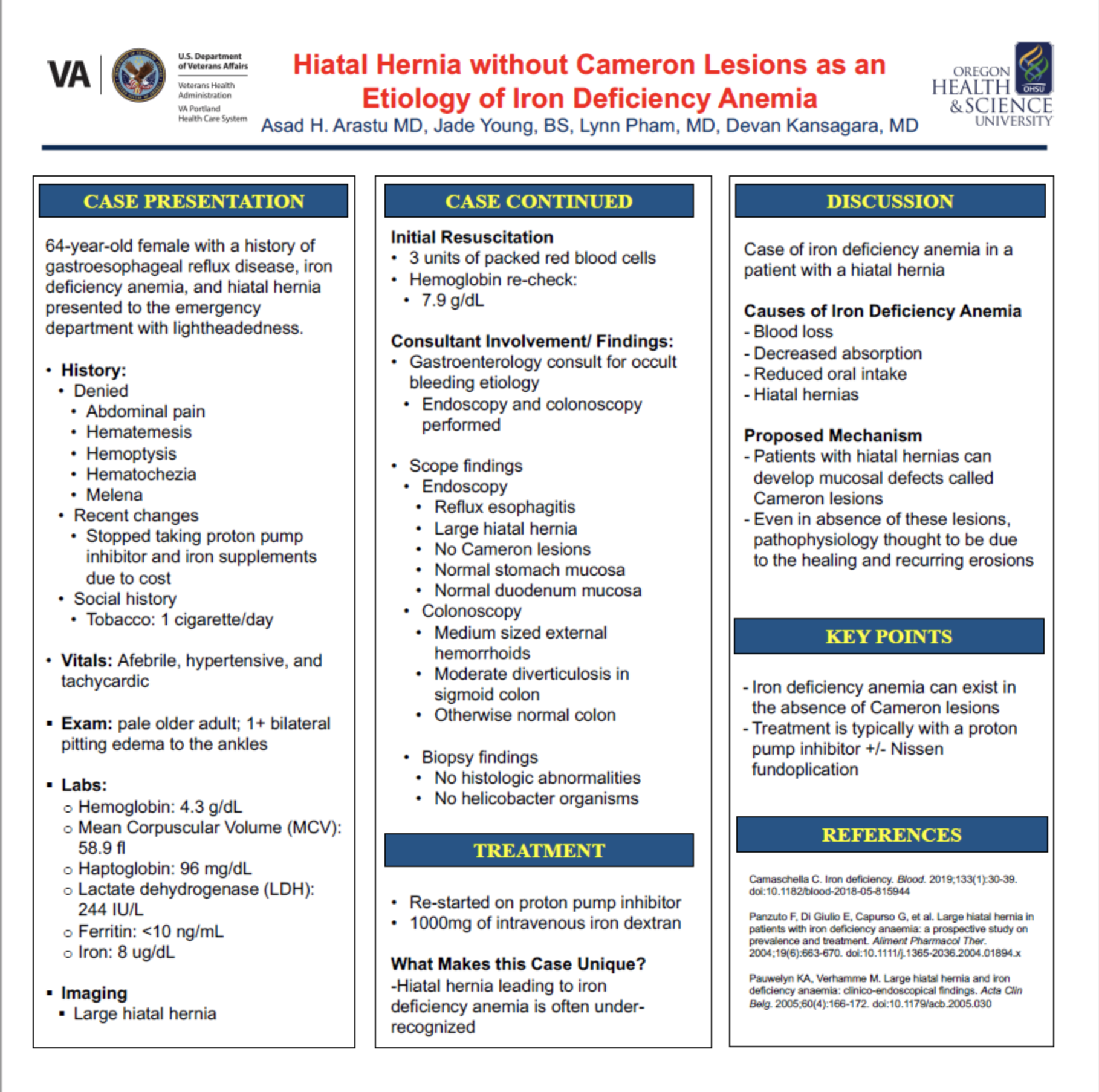
Hiatal Hernia without Cameron Lesions as an Etiology of Iron Deficiency Anemia
Asad Arastu, MD
Faculty Mentor: Devan Kansagara, MD
Patients with hiatal hernias can develop mucosal defects called Cameron lesions. Even in absence of these lesions, pathophysiology thought to be due to the healing and recurring erosions.
Andrew Balster, MD
Faculty Mentor: Alan Hunter, MD
Acute inflammatory demyelinating polyneuropathy (AIDP) is a life threatening condition involving acute onset polyneuropathy that results in ascending areflexic weakness and paralysis. AIDP often has a recognizable triggering event, classically infectious However, infections only account for two thirds of cases and has become increasingly recognized that there are also other triggering events.
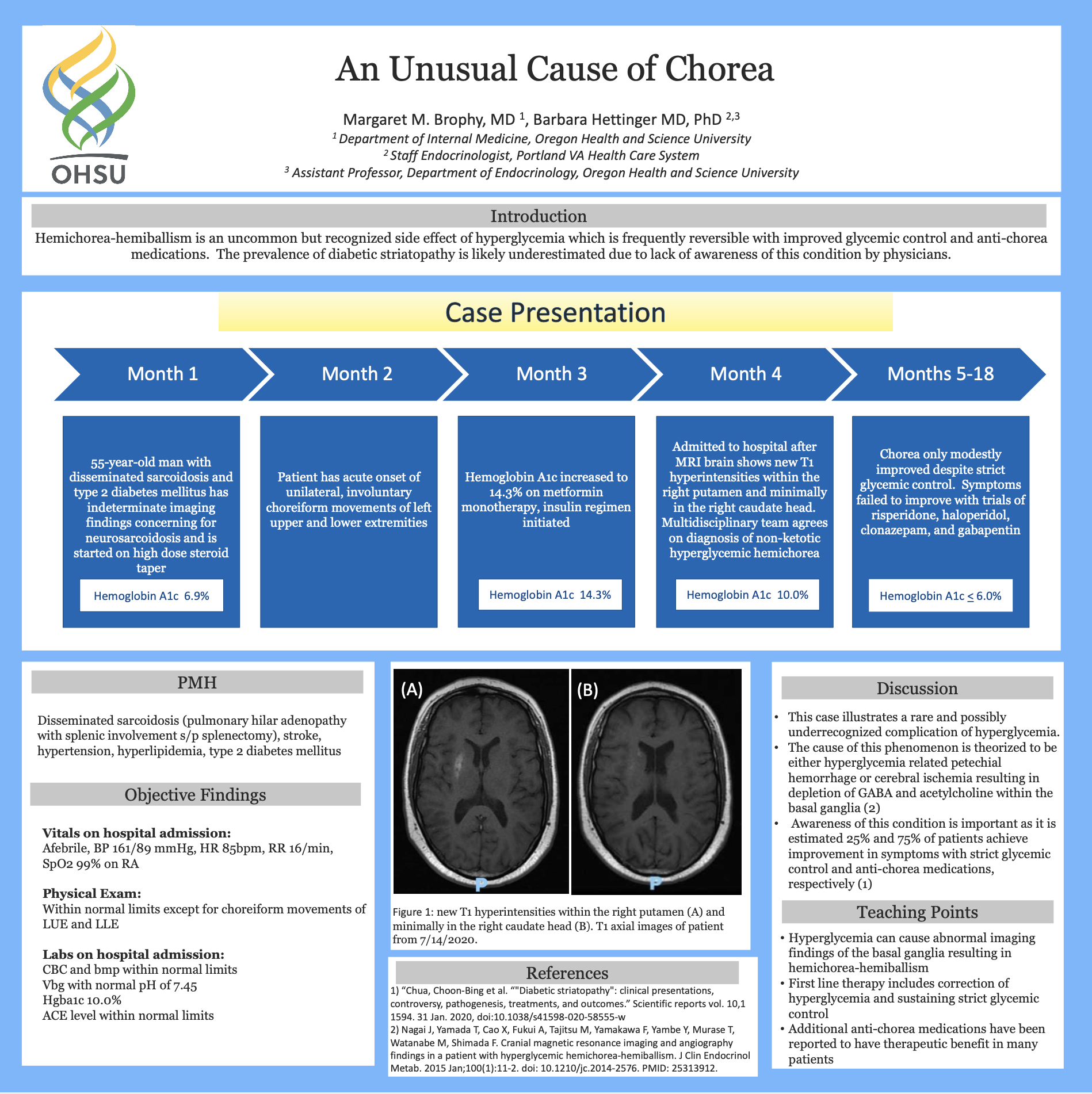
Margert Brophy, MD
Faculty Mentor: Barbara Hettinger, MD
Hemichorea-hemiballism is an uncommon but recognized side effect of hyperglycemia which is frequently reversible with improved glycemic control and anti-chorea medications. The prevalence of diabetic striatopathy is likely underestimated due to lack of awareness of this condition by physicians.
Ischemic or Genetic? Exploring the Relationship Between an LV Aneurysm and Anomalous Coronary Artery
Claire Cambron, MD
Faculty Mentors: Ahmad Masri, MD; Babak Nazer, MD
Coronary artery anomalies (CAA) are rare variants that can be diagnosed incidentally on coronary CT angiography (CCTA) during an ischemic evaluation. Reported CAA prevalence varies but may be as high as 7.9% among patients undergoing CCTA. Interestingly, additional congenital variants can coexist with CAA, including congenital left ventricular aneurysm (cLVA). The prevalence of CAA in patients with cLVA is as high as 58%. Ventricular tachycardia or fibrillation occur in 18.4% of patients with cLVA.
A Not So Sweet Complication of Crohn's Disease
Jacqueline Chang, MD
Resident collaborator: Toan Do, MD
Faculty Mentor: Rebecca Harrison, MD
Sweet syndrome (SS), also known as acute febrile neutrophilic dermatosis, is an inflammatory skin condition characterized by neutrophilic infiltration of the skin. SS can be idiopathic, and has also been associated with various infections, malignancy, inflammatory or autoimmune disorders, drugs, or pregnancy. We present a case of SS likely from IBD and/or azathioprine.
Jacqueline Chang, MD
Faculty Mentor: Dekey Lhewa, MD
Autoimmune hepatitis (AIH) can occur in all age groups and are more common in women. Presenting symptoms are often nonspecific, and can include fatigue, anorexia, nausea, jaundice, and pruritis. For some patients, it is first diagnosed in the setting of acute hepatitis. For many others, it can progress insidiously and may not be diagnosed until the stages of chronic hepatitis or cirrhosis.
Aphasia Masquerading as Delirium
Charlotte Cronenweth, MD
Faculty Mentor: Jacqueline Levene, DO
Non-bacterial thrombotic endocarditis is a rare, likely underdiagnosed non-infectious endocarditis seen in the setting of hypercoagulable states, such as autoimmune disease and advanced malignancy.
Desmoid Fibromatosis: Not Always Benign in Nature
Simone Dekker, MD
Faculty Mentor: Christopher Ryan, MD
Desmoid tumors, also known as desmoid fibromatoses, are rare, locally aggressive, benign soft tissue sarcomas with an annual incidence of between 2-4 cases per million. This case illustrates the use of chemotherapy in a patient with a large intra-thoracic desmoid tumor.
Peripheral Neuropathy and Macrocytic Anemia: A Near Miss
Simone Dekker, MD
Resident collaborators: Michelle Beam, MD
Faculty Mentor: Martha Gerrity, MD
In our case, the final diagnosis of copper deficiency was only made during noon report. While clinical reasoning errors due to cognitive biases are sometimes unavoidable, this case highlights the importance of second
opinions and feedback. By providing and receiving constructive feedback during sign-out, cross-coverage, and noon report, physicians at all stages can work as a team to minimize errors and improve patient care.
Skin Deep: Concerning Rashes with Severe Dyspnea
Toan Do, MD
Faculty Mentor: Elena Ghetie, MD
MDA5+ dermatomyositis presents with characteristic skin eruption of typical DM; however, may have normal muscle enzyme labs and more specific cutaneous presentation. Given the rapidly progressive nature ILD of MDA+ dermatomyositis, prompt diagnosis and aggressive treatment is imperative.
The Great Mimicker Co-Presenting as Breast and Eye Inflammation
Toan Do, MD
Faculty Mentor: Marcia Friedman, MD
Breast and eye inflammation are uncommon co-clinical presentation and should prompt a thorough investigation of rheumatologic etiologies.
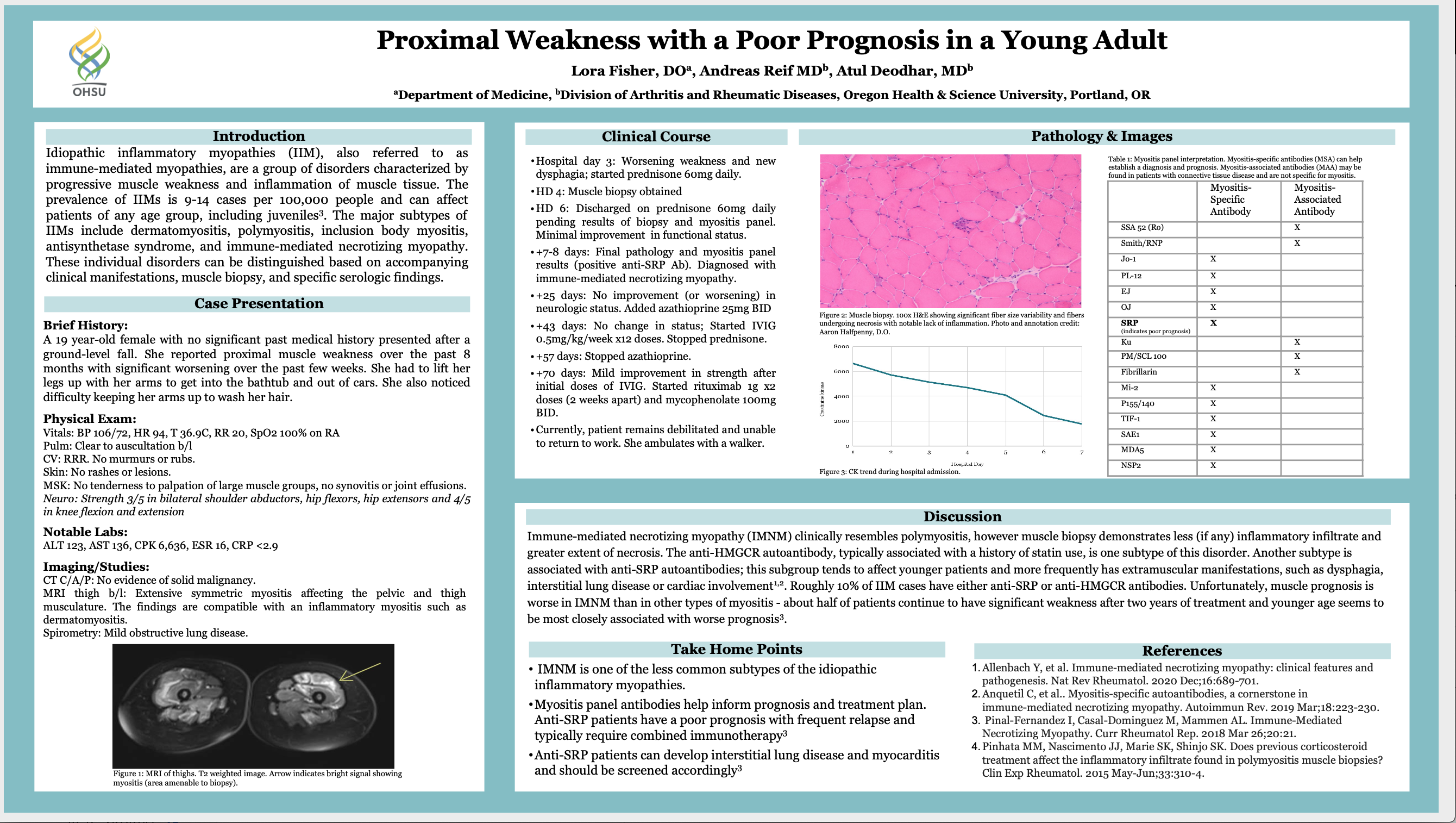
Proximal Weakness with a Poor Prognosis in a Young Adult
Lora Fisher, DO
Faculty Mentor: Atul Deodhar, MD
Idiopathic inflammatory myopathies (IIM), also referred to as immune-mediated myopathies, are a group of disorders characterized by progressive muscle weakness and inflammation of muscle tissue. The prevalence of IIMs is 9-14 cases per 100,000 people and can affect patients of any age group, including juveniles.
Treating bacteremia: Not Just about Blood Culture Clearance
Sierra Germayan, MD
Faculty Mentor: Luke Strnad, MD
Enterococcus species are commonly found in the gastrointestinal tract and can cause a variety of human infections. Enterococcus faecalis contains specific virulence factors, including adhesins, which allow for attachment to host tissues, including cardiac tissue, as well as biofilm formation. Knowledge of the pathogenesis of Enterococcus faecalis infections is crucial to ensure appropriate workup and management and avoid morbidity from the underdiagnosis and undertreatment of what is increasingly realized as one of the most common causes of infective endocarditis in cases of bacteremia.
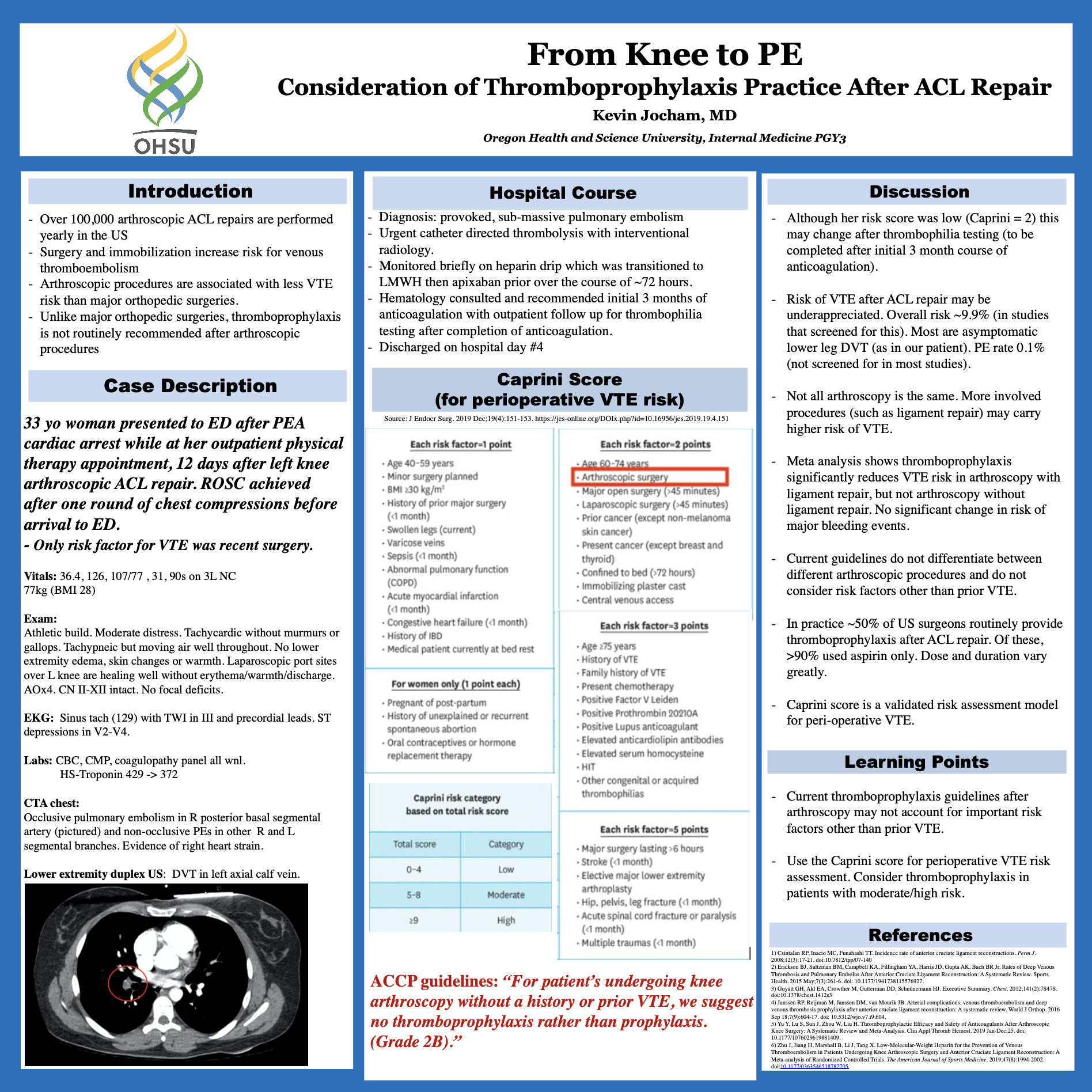
From Knee to PE: Consideration of Thromboprophylaxis Practice After ACL Repair
Kevin Jocham, MD
Arthroscopic procedures are associated with less VTE risk than major orthopedic surgeries. Unlike major orthopedic surgeries, thromboprophylaxis is not routinely recommended after arthroscopic procedures.
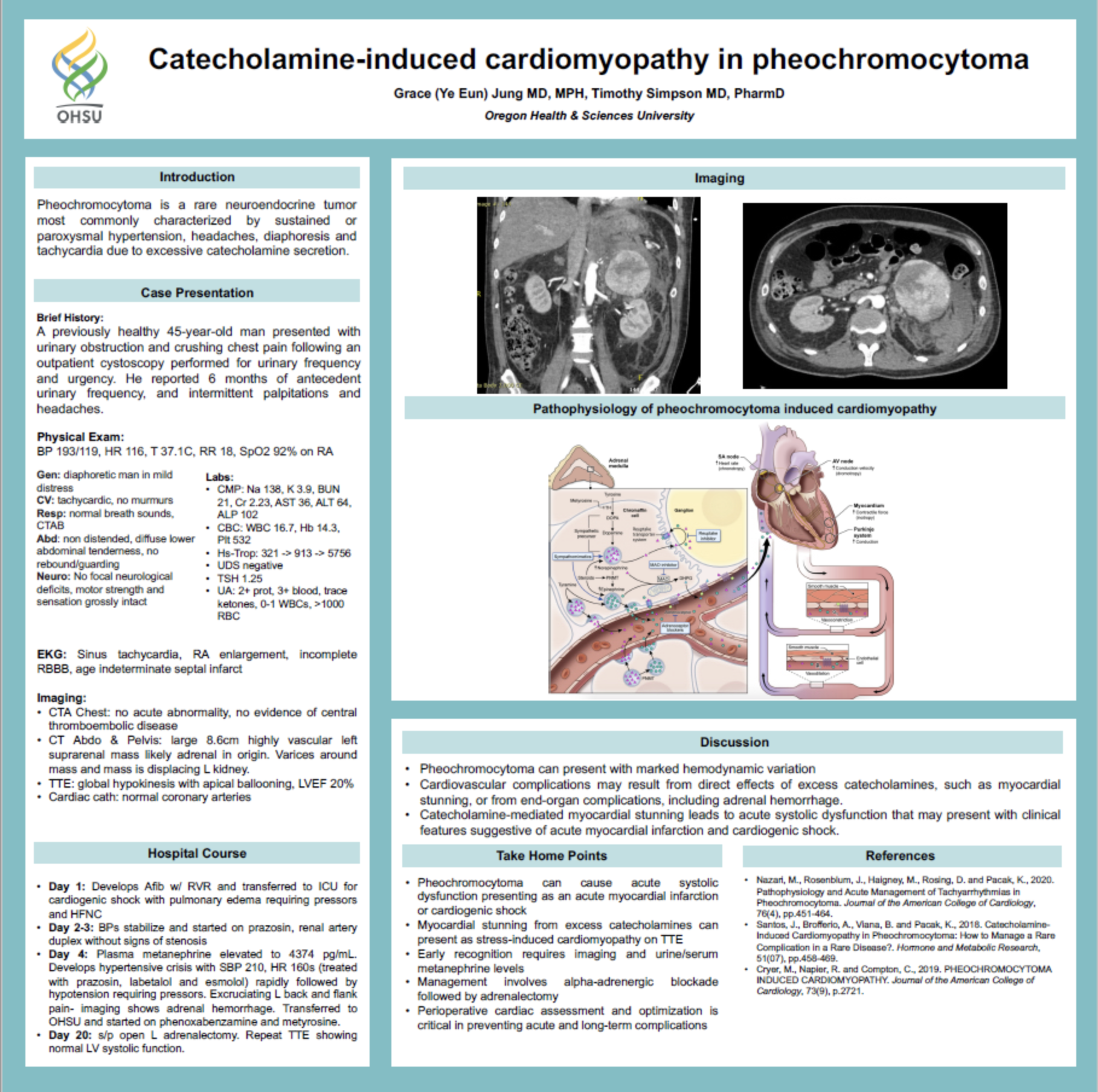
Catecholamine-induced Cardiomyopathy in Pheochromocytoma
Grace Jung, MD
Faculty Mentor: Timothy Simpson, MD
Pheochromocytoma is a rare neuroendocrine tumor most commonly characterized by sustained or paroxysmal hypertension, headaches, diaphoresis and tachycardia due to excessive
catecholamine secretion.
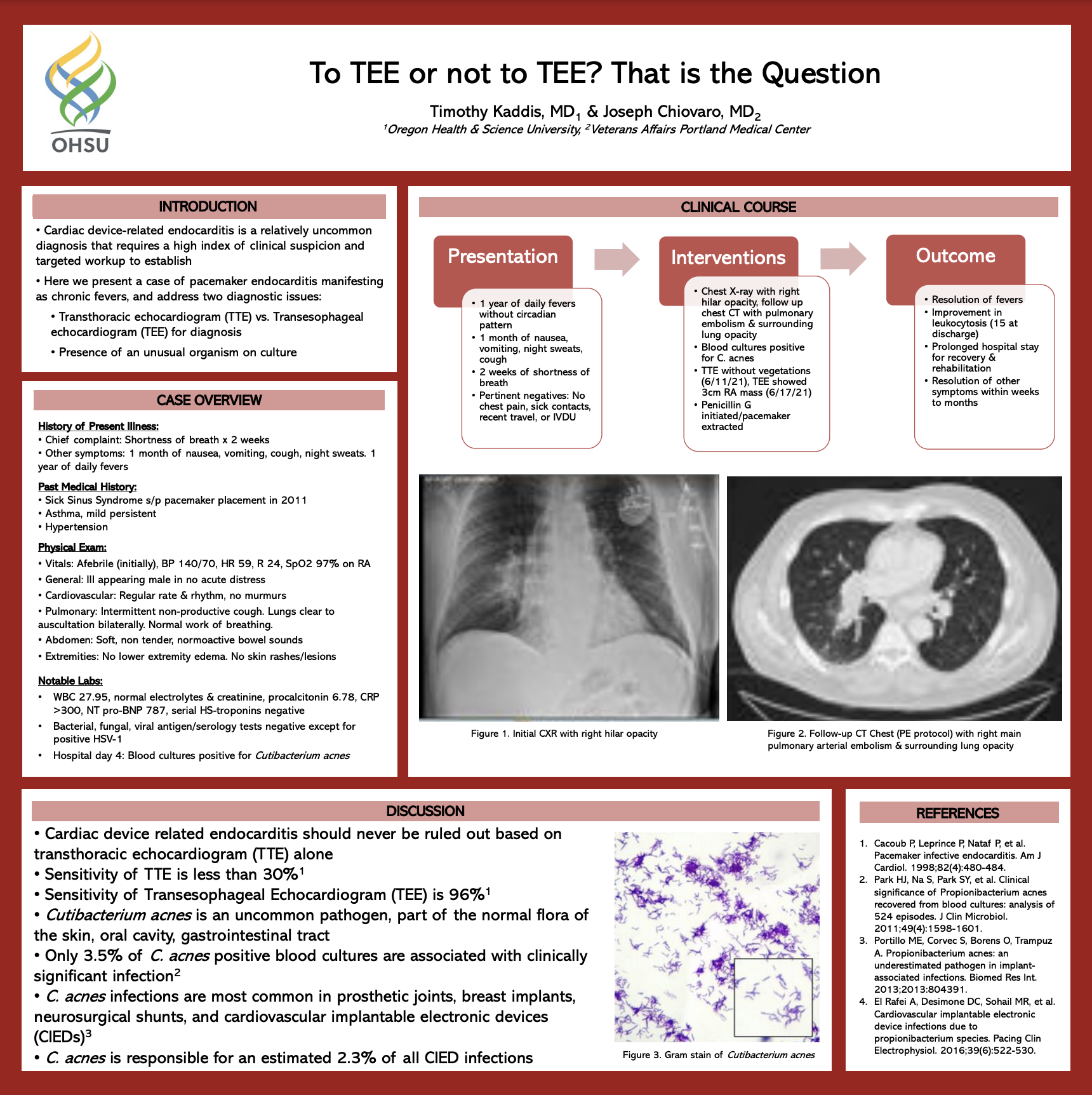
To TEE or not to TEE? That is the Question
Timothy Kaddis, MD
Faculty Mentor: Joseph Chiovaro, MD
Cardiac device-related endocarditis is a relatively uncommon diagnosis that requires a high index of clinical suspicion and targeted workup to establish. Here we present a case of pacemaker endocarditis manifesting as chronic fevers, and address two diagnostic issues.
Cardiopulmonary Compromise in the Preoperative Assessment
Ryan Kane, MD
Resident collaborators: Howard Freeman, MD; Alexis Garcia, MD; Mara Peterson, MD; Daniel Young, MD
Faculty Mentors: Elizabeth Hays, MD; Avital O'Glasser, MD
A comprehensive preoperative assessment requires a distinct perioperative thought process, incorporates historical data with clinical risk calculators, and hinges upon multidisciplinary care coordination to minimize risk.
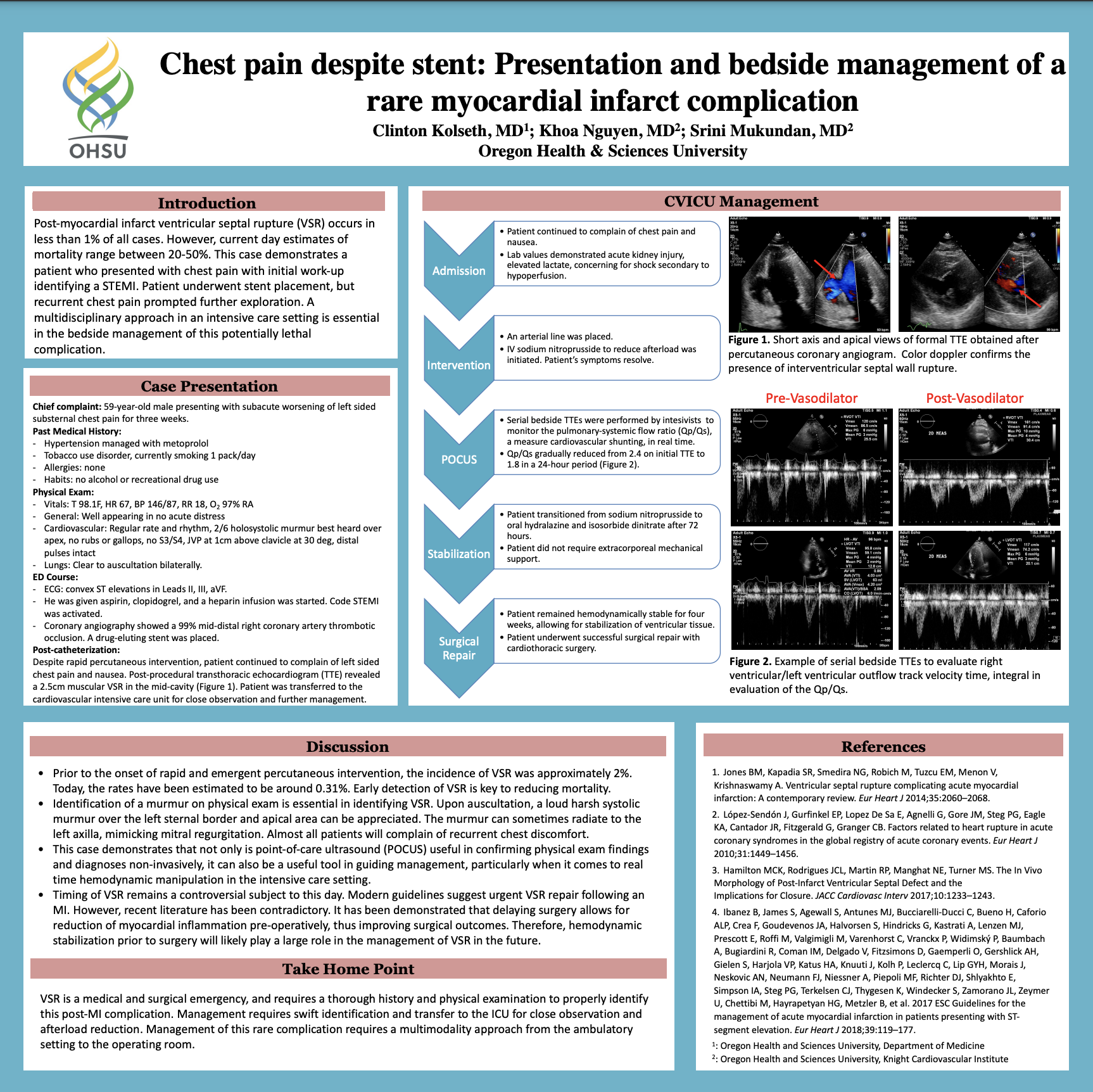
Clinton Kolseth, MD
Faculty Mentor: Srini Mukundan, MD
Ventricular septal rupture (VSR) is an uncommon but serious complication of myocardial infarction (MI). Proper timing for ventricular repair remains elusive, thus intensive medical management remains a key step in maintaining hemodynamics and reducing mortality.
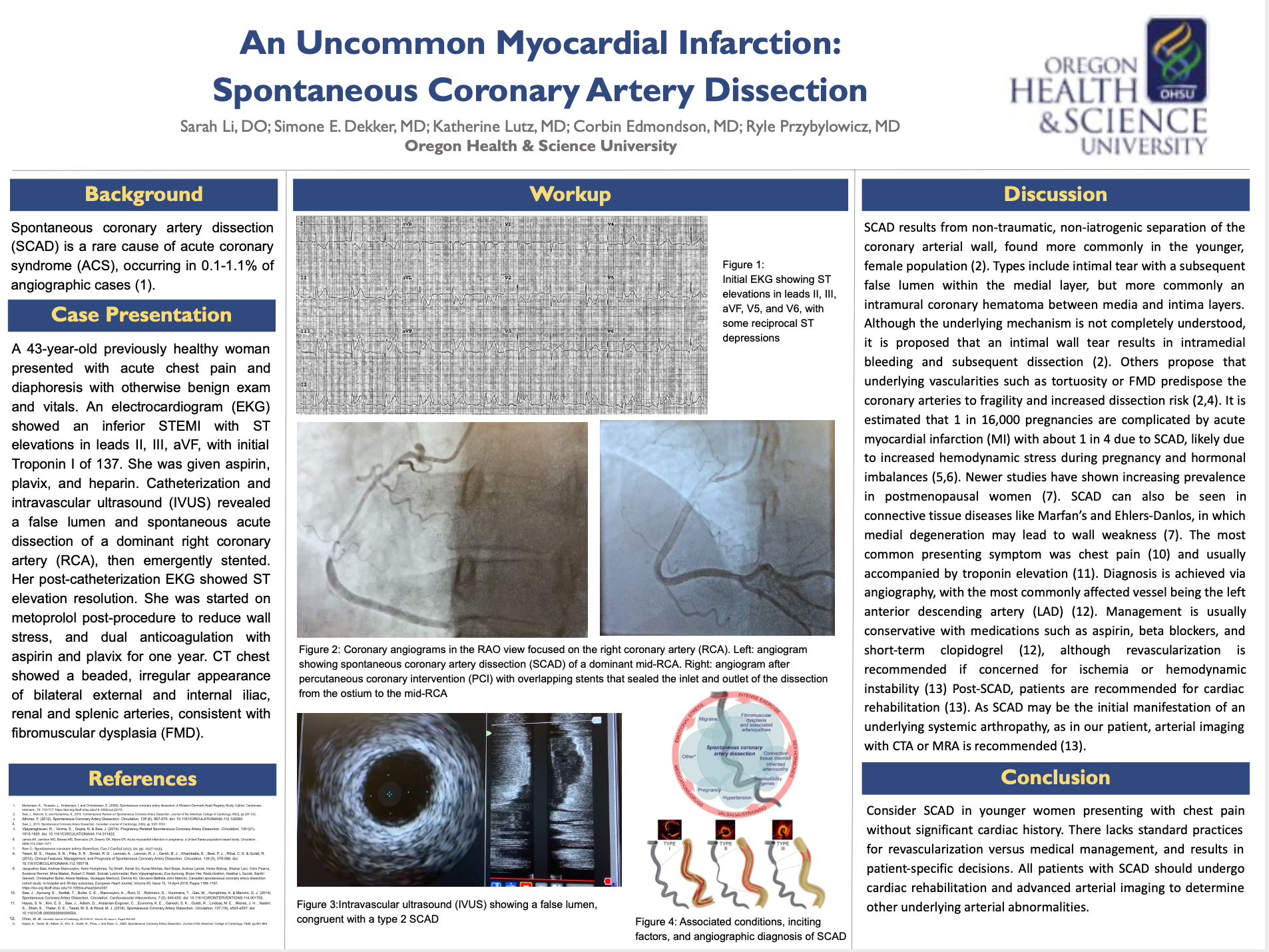
An Uncommon Myocardial Infarction: Spontaneous Coronary Artery Dissection
Sarah Li, MD
Resident collaborators: Simone Dekker, MD; Corbin Edmonson, MD; Katherine Lutz, MD
Faculty Mentor: Ryle Przybylowicz, MD
Spontaneous coronary artery dissection (SCAD) is a rare cause of acute coronary syndrome (ACS), occurring in 0.1-1.1% of angiographic cases.
The Answer is in the Aspirate, a Puzzling Case of SIRS
Brian McGarry, MD
Faculty Mentor: Kerry Rhyne, MD
Gout can manifest with SIRS and mimic sepsis. Early consideration of gout could have prevented extensive lab and imaging work up.
Amyloid Myopathy: A Challenging and Delayed Diagnosis
Ajay Mohinani, MD
Faculty Mentor: Merav Sendowski, MD
Amyloidosis is a challenging diagnosis due to several confounding factors including multi-organ involvement, variable presentations of disease and difficulty in obtaining a timely diagnosis due to availability of histopathologic stains.
A Rare Dermatologic Manifestation of COVID-19
Ajay Mohinani, MD
Resident collaborators: Erynn Beeson, MD; Jaime Scott, MD
Faculty Mentor: Bryn McGhee, MD
Greater than 600 dermatologic lesions reported with COVID-19. Interface dermatitis and vasculopathic features have been reported in isolation with COVID-19 infection but never together
A CT Diagnosis of Lymphangioleiomyomatosis (LAM) in an Asymptomatic Postmenopausal Female
Thuy-Duyen Nguyen, MD
Faculty Mentor: Suil Kim, MD
LAM should be considered for cystic findings on CT chest imaging, even in asymptomatic patients. Effectiveness of early treatment with Sirolimus in LAM remains unclear.
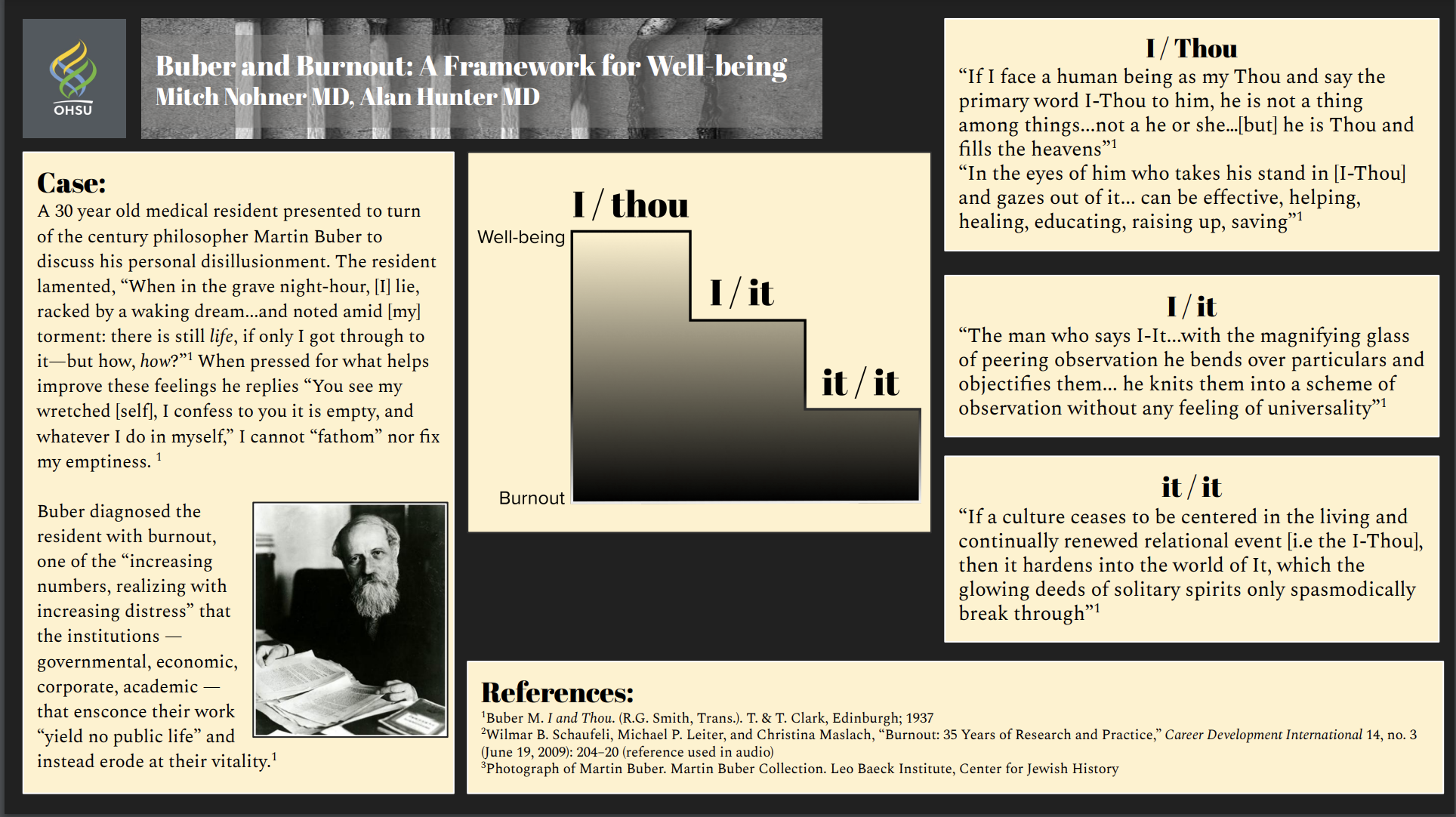
Buber and Burnout: A Framework for Well-being
Mitch Nohner, MD
Faculty Mentor: Alan Hunter, MD
Buber diagnosed the resident with burnout, one of the “increasing numbers, realizing with increasing distress” that the institutions — governmental, economic, corporate, academic — that ensconce their work “yield no public life” and instead erode at their vitality.
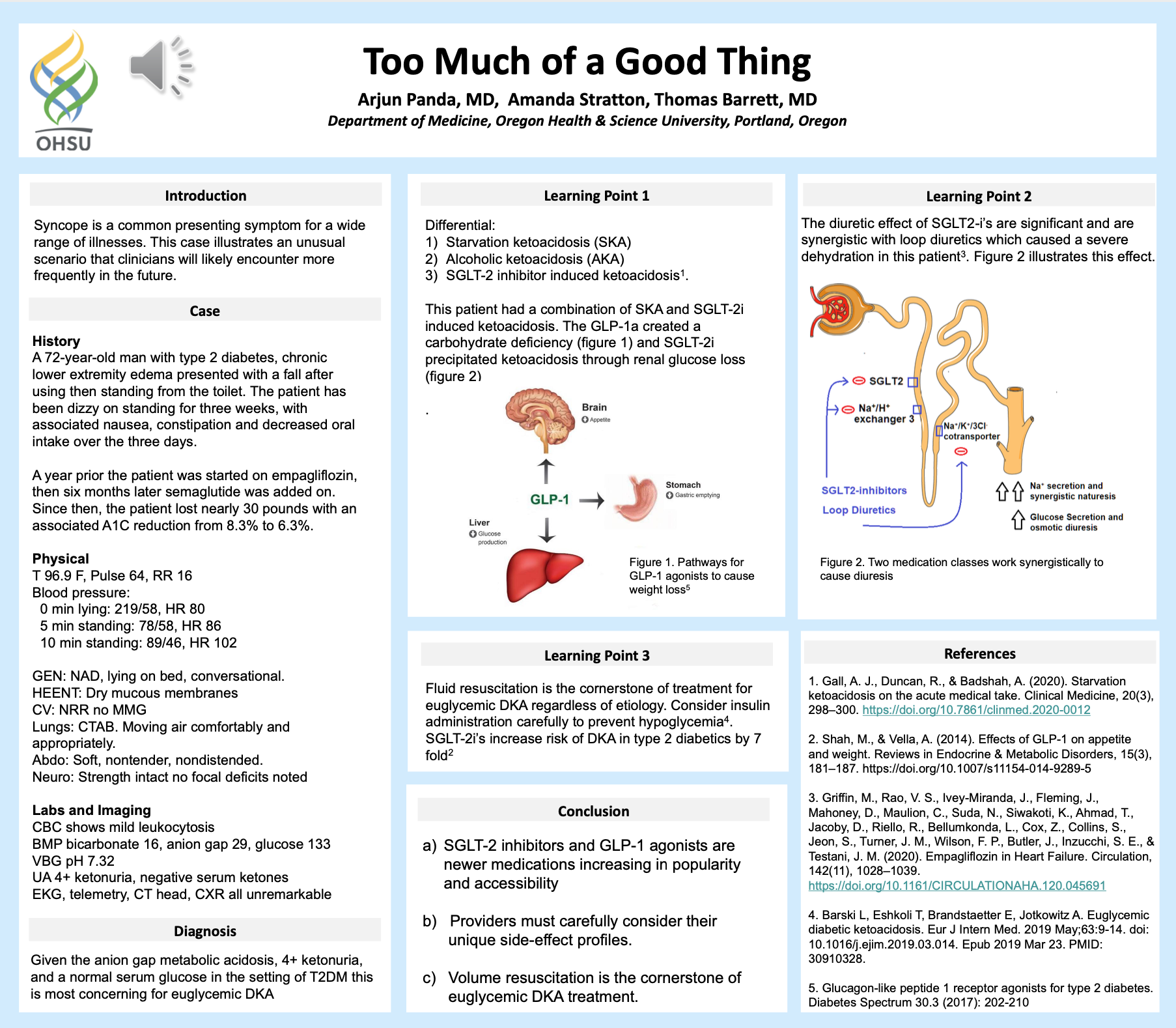
Arjun Panda, MD
Faculty Mentor: Thomas Barrett, MD
Syncope is a common presenting symptom for a wide range of illnesses. This case illustrates an unusual scenario that clinicians will likely encounter more frequently in the future.
A Case of New-Onset Visual Hallucinations in a Woman with Diabetic Retinopathy
Christine Rutlen, MD
Faculty Mentor: Alan Hunter, MD
Charles Bonnet Syndrome can present with distressing visual hallucinations in patients with preexisting visual impairment. Four questions provide a framework for characterizing visual hallucinations
A Young Patient with Severe Haemophilus influenzae Infection Presents with Acute Abdominal Pain
Jean Sabile, MD
Resident collaborators: Katherine Lutz, MD; Christine Rutlen, MD; Kristopher Van Huss, MD
Faculty Mentor: Andre Mansoor, MD
The most common etiology of acute pancreatitis is gallstone disease. However, in the absence of common alternative explanations, less common etiologies should be considered based on the patient's history and exam.
A Vexing Diagnosis: When a Somatic Mutation Results in Sustained Inflammation
Patrick Stauffer, MD
Faculty Mentor: Kenneth Scalapino, MD
This case also underscores the importance for internists to question a diagnosis that presents as a variant of the typical illness script. It also highlights a potential future in medical research that more appropriately characterizes heterogenous diagnoses as a consortium of various diagnoses that are related but may have distinct pathology, treatments and outcomes.
It Must be an Insulinoma! Case of Possible Non-Islet Cell Tumor Hypoglycemia
Scott Warner, MD
Faculty Mentor: Leah Wilson, MD
Hypoglycemia (glucose <70mg/dL) is uncommon in patients not being treated for diabetes mellitus. Patients who satisfy Whipple’s triad merit further evaluation and treatment. Triad includes documentation of hypoglycemia, presence of symptoms consistent with hypoglycemia, and relief of symptoms when plasma glucose is corrected.
Making Waves: A Case of the Apical Form of Hypertrophic Cardiomyopathy
Nicole Wong, MD
Resident collaborators: Daniel Young, MD
Faculty Mentor: Rachel Westwood, MD
Hypertrophic cardiomyopathy describes a group of myocardial diseases characterized by left ventricular hypertrophy (LVH). In these conditions, LVH arises due to alterations in cardiac myofiber organization rather than cardiac loading conditions.
Quality Improvement Research
Arinea Salas, MD
Resident collaborators: KerriAnn Finnigan, MD; Joanna Purdy, MD
Faculty Mentors: Elizabeth Eckstrom, MD; Amy Kwon, MD
Deficits in communication surrounding end-of-life (EOL) care lead to patients having unmet needs. The Ariadne Labs Serious Illness Conversations (SIC) framework is an effective tool for increasing EOL communication, but research is lacking on use with resident physicians. Resident-driven research projects are rare; protected research time, accessibility to mentors, and structured curricula promote residency research.
Prevalence and Characteristics of Patient Abuse Towards Trainee Physicians at a Single Institution
Emma DeLoughery, MD
Faculty Mentor: Tom DeLoughery, MD
Abuse from patients directed towards healthcare personnel is a worldwide problem. The goal of the study was to determine the prevalence and types of abuse experienced by residents at a single academic institution.
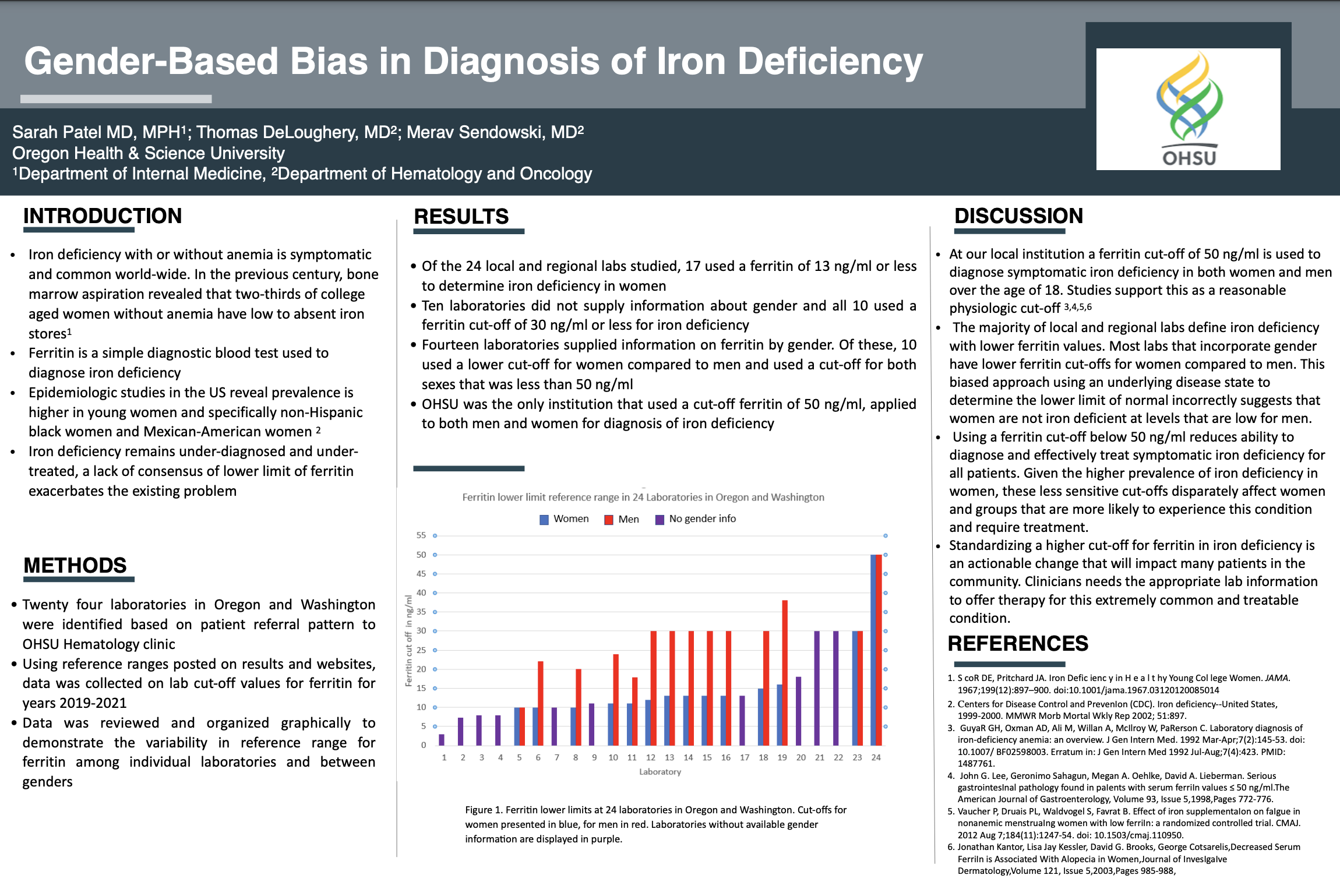
Gender-Based Bias in Diagnosis of Iron Deficiency
Sarah Patel, MD
Faculty Mentors: Tom DeLoughery, MD; Merav Sendowski, MD
Iron deficiency remains under-diagnosed and under- treated, a lack of consensus of lower limit of ferritin exacerbates the existing problem.
Clinical Research Posters
Characteristics of Fatal Marine Accidents
Emma DeLoughery, MD
Faculty Mentor: Tom DeLoughery, MD
Commercial fishing has one of the highest occupational injury and mortality rates. Merchant shipping is also risky. There is little data on characteristics of accidents involving vessels in the water. The goal of this study was to determine such characteristics in order to identify areas for improvement to reduce marine fatalities.